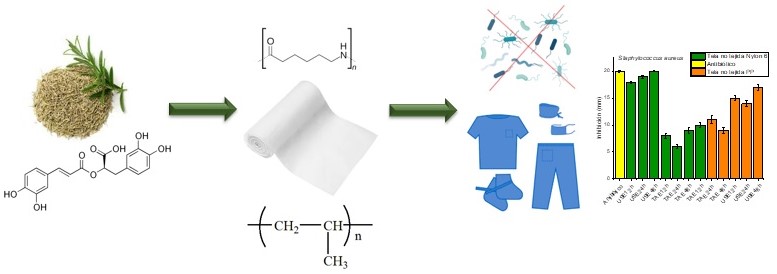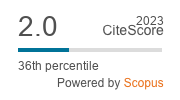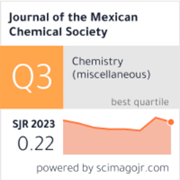Non-Woven Fabrics Based on Nylon 6 and Polipropylene Impregnated with Extracts of Rosmarinus Officinalis Obtained by Ultrasound to Provide Antibacterial Properties
DOI:
https://doi.org/10.29356/jmcs.v69i2.2074Keywords:
Nylon 6, polipropylene, extract, non-woven, antibacterial propertiesAbstract
Abstract. In the present research work, a composite with antibacterial properties against Staphylococcus aureus based on Nylon 6 and Polypropylene (PP) nonwoven fabric impregnated with extracts of Rosmarinus officinalis is presented. The extracts were obtained using ethanol as an extracting solvent getting yield percentages of 14.67 % and assisted by ultrasound with a frequency of 60 kHz. In the characterization by high-performance liquid chromatography coupled to mass, it was found that it was possible to extract families such as hydroxycinnamic acids, methoxycinnamic acids, phenolic terpenes, and catechins. The antioxidant and antibacterial capacity of Rosmarinus officinalis extracts against Staphylococcus aureus and Escherichia coli were proved. The composites obtained were characterized by FTIR-ATR infrared spectroscopy, demonstrating that when Nylon 6 and PP nonwoven fabrics were impregnated with the extracts of Rosmarinus officinalis, the corresponding bands present in the chemical structures of the secondary metabolites of Rosmarinus officinalis were shown, by means of thermogravimetric analysis characterization, the composites were found to be stable at high temperatures, and the composites were shown to possess antibacterial properties against Staphylococcus aureus.
Resumen. En el presente trabajo de investigación, se presenta la obtención de un compósito con propiedades antibacterianas frente a Staphylococcus aureus a base de tela no tejida de Nylon 6 y Polipropileno (PP) impregnado con extractos de Rosmarinus officinalis. Los extractos fueron obtenidos empleando etanol como disolvente extractor obteniendo porcentajes de rendimiento de 14.67 % y asistido por ultrasonido con una frecuencia de 60 kHz. En la caracterización por cromatografía líquida de alta resolución acoplado a masas se comprobó que se logró extraer familias como ácidos hidroxicinámicos, ácidos metoxicinámicos, terpenos fenólicos y catequinas. Se logró comprobar la capacidad antioxidante y antibacteriana de los extractos de Rosmarinus officinalis frente a Staphylococcus aureus y Escherichia coli. Los compósitos obtenidos se caracterizaron por espectroscopía de infrarrojo FTIR-ATR demostrando que al impregnar las telas no tejidas de Nylon 6 y PP con los extractos de Rosmarinus officinalis, se muestran las bandas correspondientes presentes en las estructuras químicas de los metabolitos secundarios de Rosmarinus officinalis, por medio de la caracterización de análisis termogravimétrico, se comprobó que los compósitos son estables a altas temperaturas y se demostró que los compósitos poseen propiedades antibacterianas frente a Staphylococcus aureus.
Downloads
References
Suksatan, W.; Jasim, S. A.; Widjaja, G.; Jalil, A. T.; Chupradit, S.; Ansari, M. J.; Mustafa, Y. F.; Hammoodi, H. A.; Mohammadi, M. J. Toxicol. Rep. 2022, 9, 284–292. DOI: https://doi.org/10.1016/j.toxrep.2022.02.013.
Mohammadi, M. J.; Valipour, A.; Sarizadeh, G.; Shahriyari, H. A.; Geravandi, S.; Momtazan, M.; Bahmaei, J.; Tahery, N.; Afra, A.; Rastegarimehr, B. Clin. Epidemiol. Glob. Health. 2020, 8, 954– 957. DOI: https://doi.org/10.1016/j.cegh.2020.03.003.
Vilca Yahuita, J.; Rodríguez Auad, J. P.; Philco Lima, P. Revista Médica La Paz. 2020, 26.
Bockmühl, D. P.; Schages, J.; Rehberg, L. Microbial. Cell. 2019, 6, 299–306. DOI: https://doi.org/10.15698/mic2019.07.682.
Zapata Giraldo, J.; Botero Palacio, L. E.; Mejía Suaza, M. L.; Escobar Mora, N.; Ortiz Trujillo, I.; Galeano, B.; Hoyos Palacio, L.; Cuesta, D. Revista EIA. 2018, 15, 13–29. DOI: https://doi.org/10.24050/reia.v15i29.1166.
Maya Serna, M. del P.; González Echavarría, L.; Restrepo Osorio, A. Rev. Ing. Univ. Medellin. 2017, 16, 33–54. DOI: https://doi.org/10.22395/rium.v16n31a2.
Fidan, H.; Stankov, S.; Ivanova, T.; Stoyanova, A.; Damyanova, S.; Ercisli, S. Ukr. Food J. 2019, 8, 227–238. DOI: https://doi.org/10.24263/2304-974X-2019-8-2-3.
Sassi, A.; Laouani, A.; Abdessalem, M. A. Ben; Jarray, I.; Nasrallah, H.; Ferdousi, F.; Nouira, M.; Mtiraoui, A.; Mahdhaoui, A.; Isoda, H.; Saguem, S. Phytomedicine Plus. 2025, 5, 100783. DOI: https://doi.org/10.1016/j.phyplu.2025.100783.
Contreras-Hernández, I.; Castillo-Campohermoso, M. A.; Díaz-Cervantes, E. Investigación y Desarrollo en Ciencia y Tecnología de Alimentos. 2023, 8, 920–925. DOI: https://doi.org/10.29105/idcyta.v8i1.118.
Shahidi, F.; Shi, J. Food Prod., Process. Nutr. 2019, 1, 4. DOI: https://doi.org/10.1186/s43014-019-0004-5.
Emire, S. A.; Hagos, A. D.; Eun, J. B.; Dadi, D. W. Food Technol. Biotechnol. 2019, 57, 77–86. DOI: https://doi.org/10.17113/ftb.57.01.19.5877.
Ramón, C.; Gil-Garzón, M. A. TecnoLógicas. 2021, 24.
Emire, S. A.; Hagos, A. D.; Eun, J. B.; Dadi, D. W. Food Technol. Biotechnol. 2019, 57, 77–86. DOI: https://doi.org/10.17113/ftb.57.01.19.5877.
Azuola, R.; Vargas, P. Tecnología en Marcha. 2007, 20, 30–40.
Chen, X.; Jia, X.; Yang, S.; Zhang, G.; Li, A.; Du, P.; Liu, L.; Li, C. LWT. 2022, 165, 113725. DOI: https://doi.org/10.1016/j.lwt.2022.113725.
Cabello Alvarado, C.; Caicedo Cano, C.; Melo López, L.; Andrade Guel, M.; Cruz Delgado, V. J.; Ávila Orta, C. A. Revista Iberoamericana de Polímeros. 2019, 20, 105–117.
Caicedo, C.; Melo López, L.; Cabello Alvarado, C. J.; Cruz Delgado, V.; Ávila Orta, C. A. Dyna (Medellin). 2019, 86, 288–299. DOI: https://doi.org/10.15446/dyna.v86n211.80230.
Maccaferri, E.; Mazzocchetti, L.; Benelli, T.; Zucchelli, A.; Giorgini, L. Compos B Eng. 2019, 166, 120–129. DOI: https://doi.org/10.1016/j.compositesb.2018.11.096.
Nieto, G.; Ros, G.; Castillo, J. Medicines. 2018, 5, 98. DOI: https://doi.org/10.3390/medicines5030098.
Miao, J.; Li, X.; Fan, Y.; Zhao, C.; Mao, X.; Chen, X.; Huang, H.; Gao, W. Int. J. Food Sci. Technol. 2016, 51, 1244–1251. DOI: https://doi.org/10.1111/ijfs.13076.
Alcívar Cedeño, U.; Burgos Briones, G.; Daza López, A.; Lucas Bailón, M. V. Colón Ciencias, Tecnologia y Negocios. 2021, 8, 47–59. DOI: https://doi.org/10.48204/j.colonciencias.v8n1a4.
Robles-Botero, M. V.; Ronquillo-de Jesús, E.; Quiroz-Reyes, C. N.; Aguilar-Méndez, M. A. TIP, Rev. Espec. Cienc. Quim.-Biol. 2020, 23. DOI: https://doi.org/10.22201/fesz.23958723e.2020.0.233.
Flores, E.; Villastrigo, W.; Narro, R. I.; Esparza, S. C.; Dávila, M. D.; Cabello, C. J.; Castañeda, A. O.; Sáenz, A. Afinidad. 2022, 596, 1–10.
Karadağ, A. E.; Demirci, B.; Çaşkurlu, A.; Demirci, F.; Okur, M. E.; Orak, D.; Sipahi, H.; Başer, K. H. C. S. Afr. J. Bot. 2019, 125, 214–220. DOI: https://doi.org/10.1016/j.sajb.2019.07.039.
Silverstein, R. M.; Webster, F. X., in: Spectrometric Identification of Organic Compounds, Sixth.; State University of New York, 1996.
Bendif, H.; Boudjeniba, M.; Djamel Miara, M.; Biqiku, L.; Bramucci, M.; Caprioli, G.; Lupidi, G.; Quassinti, L.; Sagratini, G.; Vitali, L. A.; Vittori, S.; Maggi, F. Food Chem. 2017, 218, 78–88. DOI: https://doi.org/10.1016/j.foodchem.2016.09.063.
Robinson, T.; Bronson, B.; Gogolek, P.; Mehrani, P. Waste Management. 2016, 48, 265–274. DOI: https://doi.org/10.1016/j.wasman.2015.11.018.
Flores, E.; Villastrigo, W.; Narro, R. I.; Esparza, S. A.; Dávila, M. D.; Cabello, C. J.; Castañeda, A. O.; Sáenz, A. Afinidad. 2022, 596, 1-10.
Briones, J.; Pascual, L. I.; Ignacio, C.; Pascual, L. A., in: Desing and Characterization of Liquid Nanocapsules of Rosemary Oil (Rosmarinus Officinalis L.). Universidad Veracruzana, Xalapa, México, 2019.
Perales Flores, J. D.; Verde-Star, Dra. M. J.; Viveros Valdéz, Dr. J. E.; Barrón-González, Dra. M. P.; Garza-Padrón, Dra. R. A.; Aguirre Arzola, Dr. V. E.; Rodríguez Garza, Dr. R. G. Biotecnia. 2022, 25, 88–93. DOI: https://doi.org/10.18633/biotecnia.v25i1.1773.
Chen, G.-L.; Chen, S.-G.; Xie, Y.-Q.; Chen, F.; Zhao, Y.-Y.; Luo, C.-X.; Gao, Y.-Q. J. Funct. Foods. 2015, 17, 243–259. DOI: https://doi.org/10.1016/j.jff.2015.05.028.
Serra Bisbal, J. J.; Melero Lloret, J.; Martínez Lozano, G.; Fagoaga, C. Interdisciplinary Ibero- American Journal of Methods, Modelling and Simulation. 2020, 12, 71–90. DOI: https://doi.org/10.46583/nereis_2020.12.577.
Martínez Jiménez, J. A.; Montero Recalde, M. A., in: Evaluación Del Efecto Bactericida Del Extracto de Romero (Rosmarinus Officinalis) in vitro En Cepa Certificada de Escherichia Coli, Facultad de Ciencias Agropecuarias, Cevallos, Ecuador, 2017.
Vela Llanos, R.; Acaro Chuquicaña, F. E., in: Efecto Antibacteriano in vitro de La Mezcla Del Aceite Esencial de Origanum Vulgare “Orégano” y Rosmarinus Officinalis “Romero” Frente a Staphylococcus aureus y Escherichia coli, Facultad de medicina humana y ciencias de la salud, Cajamarca, Perú, 2022.
Rodenas Egoavil, D. C.; Rodríguez Valqui, A.; Vilchez Caceda, H., in: Efecto Antibacteriano Del Extracto Etanolico de Tallos de Rosmarinus officinalis L. (Romero) En Cultivos de “Staphylococcus Aureus” Estudio in Vitro, Facultad de ciencias farmacéuticas y bioquímica, Lima, Perú, 2018.
Churango Valdez, J.; Vásquez Alzamora, C. A.; Sanchez Quicio, G. D., in: Efecto Antibacteriano In-Vitro de Los Extractos de Rosmarinus officinalis (Romero) y Mentha spicata (Hierba Buena) Sobre Staphylococcus aureus, Universidad de Huancayo, Huancayo, Perú, 2021.
Arévalo, Y.; Robledo, S.; Muñoz, D. L.; Granados Falla, D.; Cuca, L. E.; Delgado, G. R Rev. Colomb. Cienc. Quim.-Farm. 2009, 38, 131–141.
Guellouma, F. Z.; Boussoussa, H.; Khachba, I.; Yousfi, M.; Ziane Khoudja, I.; Bourahla, I. Nat. Prod. Res. 2024, 38, 796–806. DOI: https://doi.org/10.1080/14786419.2023.2201884.
Andrade-Guel, M.; Ávila-Orta, C. A.; Cabello-Alvarado, C.; Cadenas-Pliego, G.; Esparza-González, S. C.; Pérez-Alvarez, M.; Quiñones-Jurado, Z. V. Polymers (Basel). 2021, 13, 1888. DOI: https://doi.org/10.3390/polym13111888.

Downloads
Published
Issue
Section
License
Copyright (c) 2025 Wendy Yaneth Villastrigo-López, Aide Sáenz-Galindo, Miriam Desiree Dávila-Medina, Adali Oliva Castañeda-Facio, Christian Javier Cabello-Alvarado

This work is licensed under a Creative Commons Attribution-NonCommercial 4.0 International License.
Authors who publish with this journal agree to the following terms:
- Authors retain copyright and grant the journal right of first publication with the work simultaneously licensed under a Creative Commons Attribution License that allows others to share the work with an acknowledgement of the work's authorship and initial publication in this journal.
- Authors are able to enter into separate, additional contractual arrangements for the non-exclusive distribution of the journal's published version of the work (e.g., post it to an institutional repository or publish it in a book), with an acknowledgement of its initial publication in this journal.









